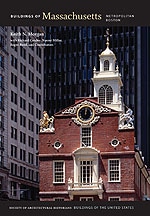
At midcentury, Harvard Yard acquired two buildings that followed the German Rundbogenstil, or round-arched style, both by Paul Schulze. The first was Appleton Chapel (1856), which Memorial Church (HY12) replaced, and the second was Boylston Hall, a science building. In its siting, Boylston Hall (1857, Schulze and Schoen; 1871, Peabody and Stearns; 1959, The Architects Collaborative [TAC]) established a southern edge for the Old Yard. Its rough granite and bold arches seem to have impressed at least one student as it was being built, H. H. Richardson, who would make his own contribution to the Yard a few years later. Peabody and Stearns added the tall mansard third story in 1871; TAC redesigned the gutted interior in 1959. With the construction of Grays Hall, a dormitory by N. J. Bradlee in 1862, the southern edge of the Old Yard was completed. Although the design of Grays Hall is austere, the three-portal organization of its brick facade with granite trim, mirroring that of Holworthy Hall (HY6.1), produces a subtle yet satisfying relationship between the two buildings.

